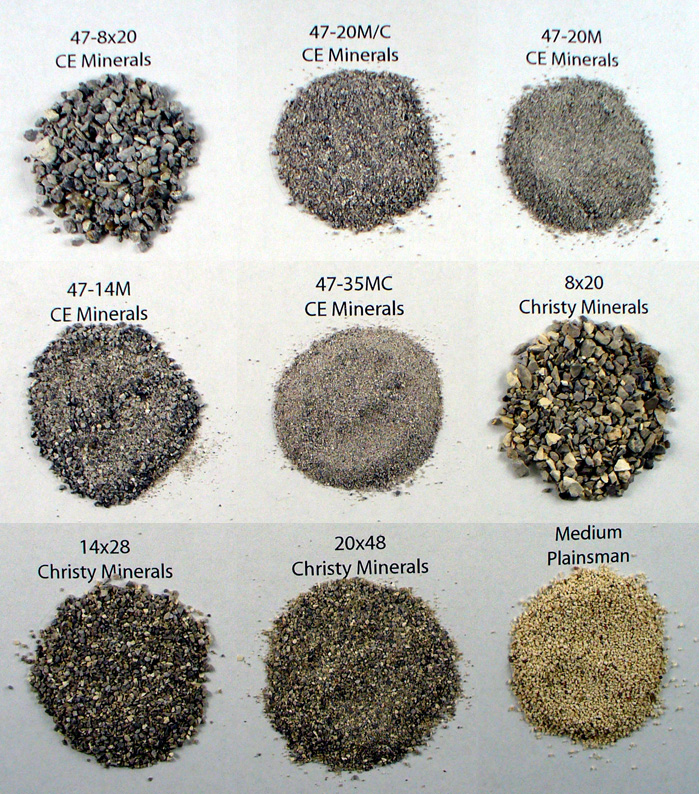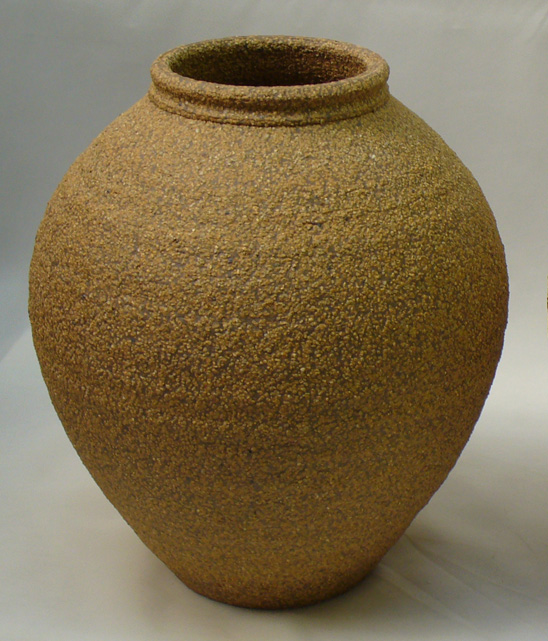| Monthly Tech-Tip | No tracking! No ads! | |
Sculpture
In ceramics, clays with added aggregate are free formed or molding into shapes that are slowly dried and fired in a kiln. The process requires much skill.
Key phrases linking here: sculpture - Learn more
Details
More info coming soon.
Related Information
A sculpture bodies gets a lot more interesting surface

This picture has its own page with more detail, click here to see it.
This is an example of how soluble salts can enhance the appearance of the fired surface of a cone 10R clay. This sculpture body is a vitreous dark brown burning base having lighter colored 20 mesh grog particles. The one on the left uses native stoneware clays that contain natural flux-containing solubles that migrate to the surface during drying. When fired they act like an extremely thin layer of glaze, producing a darker sheen on the surface. The thickness (and thus color) varies with contour and exposure of the surface during drying. The inside of the cone has no solubles at all.
Various grogs available in North America

This picture has its own page with more detail, click here to see it.
Examples of various sized grogs from CE Minerals, Christy Minerals, Plainsman Clays. Grogs are added to clays, especially those used for sculpture, hand building and industrial products like brick and pipe (to improve drying properties). The grog reduces the drying shrinkage and individual particles terminate micro-cracks as they develop (larger grogs are more effective at the latter, smaller at the former). Grogs having a narrower range of particle sizes (vs. ones with a wide range of sizes) are often the most effective additions. Grogs having a thermal expansion close to that of the fired body, a low porosity, lighter color and minimal iron contamination are the most sought after (and the most expensive).
Wow, what a surface. How?

This picture has its own page with more detail, click here to see it.
A cone 10R sculpture clay containing 40% ball clay, 10% kaolin, 10% low fire redart (for color and maturity), some quartz and 25% 20x48 grog. This fine grained base produces a body that feels smoother than it really is and is very plastic. It is even throwable on the wheel.
Grog particles from a sculpture clay body

This picture has its own page with more detail, click here to see it.
Here is the oversize (from Plainsman MSculp) on the four coarsest screens we use to do particle size distributions on clay bodies. There are very few intermediate sizes between the very fine particles of the base body and the coarse particles of the grog and sand. Contrary to what I have thought up until now, lately we have found that this approach makes for greater plasticity, better drying and less water splitting than if the grog and body contain a range of coarse to very fine particles. It also feels smooth on the wheel.
When two clays are joined are they compatible?

This picture has its own page with more detail, click here to see it.
These bi-body strips are made by rolling two clays together in a thin sandwich. Three porcelains are being compared to a very plastic grogged sculpture body. After drying (top) they curl a little, two toward the sculpture body and one, the most plastic of the porcelains, toward the white. But on firing to cone 8 they curl dramatically toward the porcelain side (because it shrinks alot more). Now imagine one of these porcelains is being used as a engobe on this body.
Perlite in a grogged sculpture body

This picture has its own page with more detail, click here to see it.
This body is a plastic fireclay base having 13% 20/48 grog and 10% 65 mesh silica sand. But the texture is far coarser than one would expect. That is because it has 4 cubic feet of perlite per thousand pound batch. If desired the surface can be trowel smooth. This works well partly because the perlite particles are soft and easy to crush.
Sculpture by Brian MacArthur

This picture has its own page with more detail, click here to see it.
This was made at the Medalta Artists in Residence program in 2014. It celebrates Jim Marshall, a local historian and ceramic artist who does architectural murals.
Sculpture by Stephanie Osser

This picture has its own page with more detail, click here to see it.
This terra cotta sculpture, called “HOPE" was made at the studio of Stephanie Osser, a collaboration with my former student Jamaal Eversley. With Covid, Jamaal had to finish it with acrylic paint. HOPE was exhibited during the 2 months of the Boston Exhibit called “ Real Friends” summer 2020.
Why you need to know about spalling

This picture has its own page with more detail, click here to see it.
It is easy to find pictures of spalling bricks at google. This happens because water trapped in the pores of ceramic and concrete expands during freezing and breaks it down. This should be a concern to people making architectural and sculpture pieces for outdoors. How do you know if your ceramic will spall? It needs open and closed pore space if over 1% closed porosity. Measure the percentage gain in weight (of a test tile) after a 24-hour water soak, that is 'open porosity'. Then boil for 5 hours and it will soak up more water, measure that as the % closed porosity. The second number needs to be 20% greater than the first. Why? The closed space provides a place for expansion as the water is freezing.
How can Craft Crank sculpture clay be so plastic and smooth with this much grog?

This picture has its own page with more detail, click here to see it.
The super-smooth clay on the left is "Industrial Crank" from Potclays in the UK, I have removed the grog (our test code number L3868). First I did our standard tests on that body, then I dried some, slaked it in water, screened the grog out and then dewatered the remaining clay to plastic form. The grog yielded weighed the same as the clay portion of the recipe yet this body is known for amazing workability and toughness! How is that possible with so much aggregate in the recipe? The base clay body is extremely smooth, sticky and highly plastic. Mixtures of just ball clay and feldspar (e.g. 75:25) will yield this type of material, some ball clays will produce as little as 6% drying shrinkage using this ratio. The grog they use is also special: The particles have angular shapes and a narrow range of sizes, from about 35 mesh to 70 mesh (most is of the coarsest size). This narrow range of sizes means dramatically less particle surface area. These factors produce much less disruption of the plastic properties of the base clay. How could you make a body like this? Slurry up about 75% ball clay and 25% feldspar and wedge the grog into that.
Links
| Glossary |
Grog
Grog is a term used in ceramics to describe crushed brick (or other fired ceramic) aggregate that is added to sculpture and structural clays to improve drying properties. |
| URLs |
https://shop.sculpt.com
The Compleat Sculptor - Sculpting supplies |
| URLs |
https://sculpturesupply.com/
Sculpture Supply - Canada dealer for SmoothOn |
| URLs |
https://www.smooth-on.com/product-line/mold-max/
SmoothOn MoldMax 40 silicone rubber by moldmaking for sculpture |
| URLs |
https://vimeo.com/454082486
Making of the HOPE sculpture By Jamaal Eversley and Stephanie Osser |
| By Tony Hansen Follow me on        |  |
Got a Question?
Buy me a coffee and we can talk

https://digitalfire.com, All Rights Reserved
Privacy Policy
